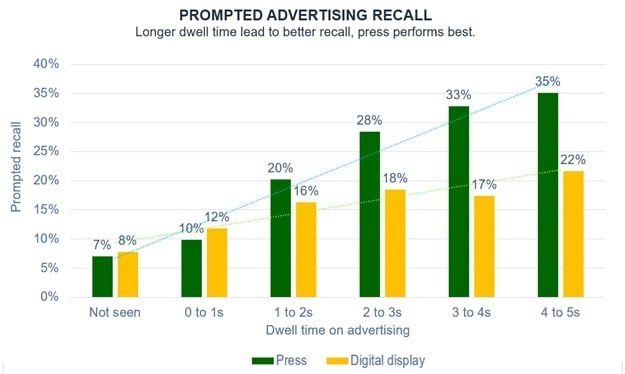
Top stories



Lumen is an attention technology company that uses eye-tracking cameras to measure the actual visual engagement readers have with various media types. “The technology is brilliant, and by using existing webcams in computers drastically reduces costs and eliminates the biggest problem in all research, that of claimed vs. actual behaviour,” says Peter Langschmidt, research consultant to the PRC (Publisher Research Council). The software passively monitors the respondent’s web browsing as well as eye movement on every page and plots a ‘heat map’ of whatever content and advertising is being viewed.”

While print adverts are more viewable and achieve longer dwell times than their online counterparts, this is not the entire story, as quality content plays an important role as well.
There are wide variations in how different media perform, some sites and ad formats perform far better than others. The best sites do a much better job of delivering attention for advertisers than the average, with as much as 56% of viewable impressions being noticed. In fact, on average, ads on Newsbrand platforms are almost twice as likely to be seen than those on other websites, and they achieve longer dwell times.

Alignment between the advertising and the content also helps facilitate ad attention. This contextual relevance matters. Experimental studies have found that placing ads in a contextually relevant environment can boost attention dramatically. Testing shows just how much context matters, as ads placed within the right context get 692 times more attention than those simply placed in any environment.

The fundamental element of any advertising message working is first actually seeing the advert and secondly, dwell time that allows for cognition to impart the message. The longer consumers look at ads, the more likely they are to remember the message and act upon it.
Anyone who has ever studied for an exam or test knows that reading is the best way to learn and that the longer one studies the more familiar one becomes with the course material.
Does this also apply to advertising and brand recall? Well, there’s a simple way to find out. Just like exams they can simply ask respondents to do a prompted advertising recall test.

These results, gleaned from many studies over several years, conclusively prove the theory of dwell times precisely linking back to recall.
The final and most important step that advertising must accomplish is to encourage purchase, for it is here that the advertiser receives their return on investment (ROI). To complete the purchase journey and prove this, Lumen installed their eye-tracking technology onto a subsample of an existing FMCG consumer panel belonging to Nectar in the UK.
By linking the initial online advertising interaction of the panel with their subsequent offline shopping behaviour, they can see the dramatic effect that actual viewing of advertising has.

As can be seen, across these 10 Nectar brands, the average upliftment of sales during the campaign was 2%, but amongst those who actually looked at the advert, this was 8.5 times more at 17%.
Media planning is traditionally based on possible exposure, an opportunity to see, but this metric is becoming more and more irrelevant, because if consumers don’t even view an advert, how can it possibly change behaviour? With this new measure, they can track the difference in sales between those who actually looked at the advert and those who did not.
The Lumen data shows that the best ad inventory facilitates communication with consumers when they are in the right mood to be receptive to advertising messages, and then creates the time and space to enable advertisers to get their messages across.
“This is dynamite,” concludes Langschmidt. “Until now we have been unable to measure actually viewed impressions.
No matter the reading platform, to maximise advertising exposure, the advert must firstly be seen for a period of time. Different platforms perform differently, the media environment affects a reader’s attention and finally, context matters.”
For additional information and reading research click here.